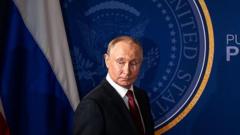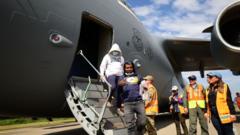With China and Russia leading the charge in hypersonic missile development, the U.S. and its allies grapple with the urgency to catch up. Experts discuss the challenges these advanced weaponry pose, including detection difficulties and the need for enhanced defense systems.**
Accelerating Arms Race: The Hypersonic Missile Challenge and Global Security**

Accelerating Arms Race: The Hypersonic Missile Challenge and Global Security**
As nations strive to advance their hypersonic missile technology, experts warn of the implications for global security and the balance of power.**
In the shadow of a military parade in Beijing, China's hypersonic missile arsenal, once merely a point of speculation, has now emerged as a formidable reality. The Dongfeng-17 (DF-17), introduced on October 1, 2019, is a prime example of China's rapid advancement in military technology. Capable of hyper-speed travel — over five times the speed of sound — these weapons promise to revolutionize warfare and alter global security dynamics.
The current landscape reveals a fierce international battle primarily between China, Russia, and the United States, as they race to develop hypersonic capabilities. Hypersonic weapons have shifted the strategic focus, as states recognize the necessity of reinvigorating their defenses against these advanced systems. “This resurgence of focus on hypersonics is a response to the growing military capabilities of China and Russia,” states William Freer from the Council on Geostrategy.
While China leads this technological frontier, Russia is also making strides, with President Vladimir Putin showcasing an array of hypersonic missiles, including the Kinzhal and Avangard. As nations advance their missile programs, Western nations, especially the U.S. and the UK, are scrambling to enhance their deterrence capabilities. The potential for these weapons to travel at speeds exceeding Mach 5 complicates interception and detection, calling for innovative detection technologies.
Analysts point out that Western powers, notably the U.S., are underestimating the scope of the hypersonic advancements from their rivals. With Israel and Iran also entering this arena, the situation becomes increasingly complex. The impending threat level demands a robust response, underscoring the need for improved space-based sensors to counter hypersonic maneuverability and speed.
Despite the alarming pace of technological development, there is skepticism surrounding the supposed invincibility of these hypersonic weapons. Experts like Dr. Sidharth Kaushal maintain that while hypersonic missiles offer unique advantages against key targets, their perceived supremacy might be overstated, with capable countermeasures available.
As the race intensifies, discussions around both offensive capabilities and potential defenses become paramount. With the UK recognizing the urgent need to catch up, active collaborations are underway to advance research and testing. The successful propulsion tests conducted earlier this year signal progress, yet it highlights the long road ahead to operational capabilities.
Ultimately, while hypersonic technology marks a notable evolution in military capabilities, it remains crucial for nations to balance advancing offensive systems with strong defensive strategies to maintain global stability and avert conflicts. As the arms race unfolds, the intricate dynamics of hypersonic technology will shape the future of warfare and international relations.



















